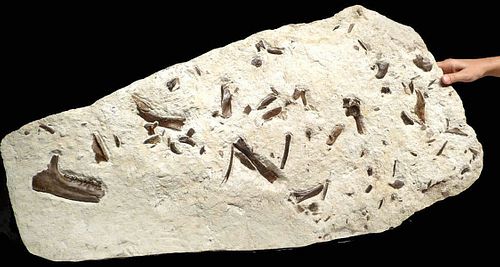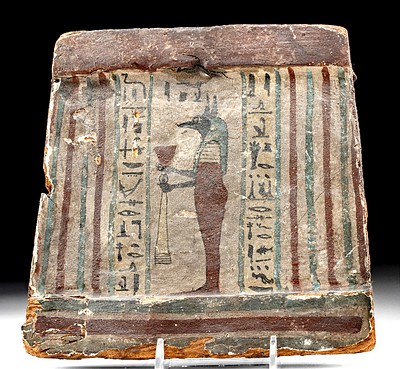Rare Fossilized Plagiolophus 3-Toed Horse Bones Matrix
Lot 79
About Seller
Artemis Fine Arts
686 S Taylor Ave, Ste 106
Louisville, CO 80027
United States
Selling antiquities, ancient and ethnographic art online since 1993, Artemis Gallery specializes in Classical Antiquities (Egyptian, Greek, Roman, Near Eastern), Asian, Pre-Columbian, African / Tribal / Oceanographic art. Our extensive inventory includes pottery, stone, metal, wood, glass and textil...Read more
Estimate:
$5,000 - $7,500
Absentee vs Live bid
Two ways to bid:
- Leave a max absentee bid and the platform will bid on your behalf up to your maximum bid during the live auction.
- Bid live during the auction and your bids will be submitted real-time to the auctioneer.
Bid Increments
| Price | Bid Increment |
|---|---|
| $0 | $25 |
| $300 | $50 |
| $1,000 | $100 |
| $2,000 | $250 |
| $5,000 | $500 |
| $10,000 | $1,000 |
| $20,000 | $2,500 |
| $50,000 | $5,000 |
| $100,000 | $10,000 |
| $200,000 | $20,000 |
About Auction
By Artemis Fine Arts
Aug 26, 2021
Set Reminder
2021-08-26 10:00:00
2021-08-26 10:00:00
America/New_York
Bidsquare
Bidsquare : Fine Antiquities | Asian | Ethnographic Art
https://www.bidsquare.com/auctions/artemis-gallery/fine-antiquities-asian-ethnographic-art-7366
Features classical antiquities, ancient and ethnographic art from cultures encompassing the globe. Egyptian, Greek, Roman, Etruscan, Near Eastern, Asian, Pre-Columbian, Native American, African / Tribal, Oceanic, Spanish Colonial, Russian, Fine / Visual Arts, so much more! Artemis Fine Arts info@artemisfinearts.com
Features classical antiquities, ancient and ethnographic art from cultures encompassing the globe. Egyptian, Greek, Roman, Etruscan, Near Eastern, Asian, Pre-Columbian, Native American, African / Tribal, Oceanic, Spanish Colonial, Russian, Fine / Visual Arts, so much more! Artemis Fine Arts info@artemisfinearts.com
- Lot Description
Western Europe, France, Middle Eocene period, ca. 48 million years ago. This is an exceedingly rare stone matrix containing fossilized bones from prehistoric Plagiolophus three-toed horses. Limb bones are clearly visible, and rather than a single bone or tooth, which are more common finds, this is a densely packed fossil bed of many pieces from multiple animals! Note the jaw mandible section with the original molars still intact, and several other individual teeth including incisors and molars with their full crown and root! The natural dark espresso brown of the fossils contrasts remarkably well with the lighter color of the surrounding stone matrix. The reinforced back side is ground flat and simply needs some custom brackets to display this magnificent piece. This is a perfect and amazing fossil to add to any collection and marks the dawning age of horses in prehistory! Size: 37" L x 1.5" W x 19.25" H (94 cm x 3.8 cm x 48.9 cm)
Plagiolophus, or primitive horse fossils, are usually limited to isolated finds of teeth and some bones; those fossils are often from either the Pliocene or Miocene Periods. This is an extremely unique example of a primitive three-toed horse from before those periods! This matrix dates to the Eocene Era which is the geologic period that marks the emergence of the horse! This is a spectacular exhibition-grade fossil appropriate for museum collections. It is a valuable example of Eocene mammalian evolution and a cornerstone specimen of horse evolution and early development. The unusually large size of the matrix and plate-like, flat nature make it easy to exhibit on a wall thereby not requiring any valuable floor display space. A specimen like this could even make a perfect feature display on the premises of a horse-breeder or equestrian estate. Most people do not realize that the earliest of primitive horses from the time of this fossil, were about the size of a modern fox and horse evolution dates as far back as 60 million years ago. Numerous extremely well-preserved bones and teeth of this Plagiolophus species can be found naturally fossilized together in this stone matrix. This is a one-of-a-kind specimen of both great scientific importance as well as exhibition visual appeal.
Provenance: private Diamond Springs, California, USA collection, acquired 2006; ex-private French collection
All items legal to buy/sell under U.S. Statute covering cultural patrimony Code 2600, CHAPTER 14, and are guaranteed to be as described or your money back.
A Certificate of Authenticity will accompany all winning bids.
PLEASE NOTE: Due to recent increases of shipments being seized by Australian & German customs (even for items with pre-UNESCO provenance), we will no longer ship most antiquities and ancient Chinese art to Australia & Germany. For categories of items that are acceptable to ship to Australia or Germany, please contact us directly or work with your local customs brokerage firm.
Display stands not described as included/custom in the item description are for photography purposes only and will not be included with the item upon shipping.
#166807Professionally excavated. Original bones and teeth in natural positions as found in stone matrix. Not an assembled composite or artificial matrix. The edges of the slab show embedded bones that have been cut during the excavation of this matrix. The back has an epoxy coating to preserve the surface, and brackets could be added to display this piece!Condition
- Shipping Info
-
All shipping is handled in-house for your convenience. Your invoice from Artemis Gallery will include shipping calculation instructions. If in doubt, please inquire BEFORE bidding for estimated shipping costs for individual items.
-
- Buyer's Premium



 EUR
EUR CAD
CAD AUD
AUD GBP
GBP MXN
MXN HKD
HKD CNY
CNY MYR
MYR SEK
SEK SGD
SGD CHF
CHF THB
THB














